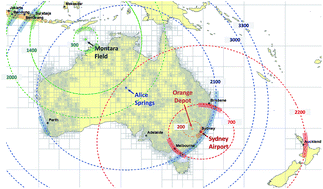当前位置:
X-MOL 学术
›
Environ. Sci.: Processes Impacts
›
论文详情
Our official English website, www.x-mol.net, welcomes your feedback! (Note: you will need to create a separate account there.)
Source-to-exposure assessment with the Pangea multi-scale framework – case study in Australia†
Environmental Science: Processes & Impacts ( IF 5.5 ) Pub Date : 2017-12-13 00:00:00 , DOI: 10.1039/c7em00523g Cedric Wannaz 1, 2, 3, 4 , Peter Fantke 5, 6, 7, 8, 9 , Joe Lane 10, 11, 12, 13 , Olivier Jolliet 1, 2, 3, 4
Environmental Science: Processes & Impacts ( IF 5.5 ) Pub Date : 2017-12-13 00:00:00 , DOI: 10.1039/c7em00523g Cedric Wannaz 1, 2, 3, 4 , Peter Fantke 5, 6, 7, 8, 9 , Joe Lane 10, 11, 12, 13 , Olivier Jolliet 1, 2, 3, 4
Affiliation

|
Effective planning of airshed pollution mitigation is often constrained by a lack of integrative analysis able to relate the relevant emitters to the receptor populations at risk. Both emitter and receptor perspectives are therefore needed to consistently inform emission and exposure reduction measures. This paper aims to extend the Pangea spatial multi-scale multimedia framework to evaluate source-to-receptor relationships of industrial sources of organic pollutants in Australia. Pangea solves a large compartmental system in parallel by block to determine arrays of masses at steady-state for 100 000+ compartments and 4000+ emission scenarios, and further computes population exposure by inhalation and ingestion. From an emitter perspective, radial spatial distributions of population intakes show high spatial variation in intake fractions from 0.68 to 33 ppm for benzene, and from 0.006 to 9.5 ppm for formaldehyde, contrasting urban, rural, desert, and sea source locations. Extending analyses to the receptor perspective, population exposures from the combined emissions of 4101 Australian point sources are more extended for benzene that travels over longer distances, versus formaldehyde that has a more local impact. Decomposing exposure per industrial sector shows petroleum and steel industry as the highest contributing industrial sectors for benzene, whereas the electricity sector and petroleum refining contribute most to formaldehyde exposures. The source apportionment identifies the main sources contributing to exposure at five locations. Overall, this paper demonstrates high interest in addressing exposures from both an emitter perspective well-suited to inform product oriented approaches such as LCA, and from a receptor perspective for health risk mitigation.
中文翻译:

Pangea多尺度框架的从源到暴露评估–澳大利亚案例研究†
缺乏能够将相关排放源与处于危险中的受体种群联系起来的综合分析方法,常常限制了减轻流域污染的有效计划。因此,既需要发射器角度也要使用接收器角度,才能始终如一地告知减少排放和暴露的措施。本文旨在扩展Pangea空间多尺度多媒体框架,以评估澳大利亚有机污染物的工业来源的源到受体关系。Pangea逐块求解大型隔室系统,以确定100000+隔室和4000+排放情景下稳态的质量阵列,并通过吸入和摄入进一步计算人口暴露。从发射器的角度来看,人口摄入的径向空间分布显示从0开始的进气分数具有很大的空间变化。苯的浓度为68至33 ppm,甲醛的浓度为0.006至9.5 ppm,与城市,农村,沙漠和海洋源位置形成鲜明对比。将分析扩展到受体的角度来看,从4101澳大利亚点源排放的总排放量中暴露出来的人群暴露的苯越多,传播距离就越长,与甲醛相比,甲醛对当地的影响更大。每个工业部门的分解暴露表明,石油和钢铁工业是苯的最大贡献工业部门,而电力部门和石油精炼对甲醛的暴露贡献最大。来源分配确定了在五个地点造成暴露的主要来源。总体而言,本文从非常适合于告知诸如LCA之类的面向产品的方法的发射器角度以及从减轻健康风险的受体角度,显示出对解决暴露问题的浓厚兴趣。
更新日期:2017-12-13
中文翻译:

Pangea多尺度框架的从源到暴露评估–澳大利亚案例研究†
缺乏能够将相关排放源与处于危险中的受体种群联系起来的综合分析方法,常常限制了减轻流域污染的有效计划。因此,既需要发射器角度也要使用接收器角度,才能始终如一地告知减少排放和暴露的措施。本文旨在扩展Pangea空间多尺度多媒体框架,以评估澳大利亚有机污染物的工业来源的源到受体关系。Pangea逐块求解大型隔室系统,以确定100000+隔室和4000+排放情景下稳态的质量阵列,并通过吸入和摄入进一步计算人口暴露。从发射器的角度来看,人口摄入的径向空间分布显示从0开始的进气分数具有很大的空间变化。苯的浓度为68至33 ppm,甲醛的浓度为0.006至9.5 ppm,与城市,农村,沙漠和海洋源位置形成鲜明对比。将分析扩展到受体的角度来看,从4101澳大利亚点源排放的总排放量中暴露出来的人群暴露的苯越多,传播距离就越长,与甲醛相比,甲醛对当地的影响更大。每个工业部门的分解暴露表明,石油和钢铁工业是苯的最大贡献工业部门,而电力部门和石油精炼对甲醛的暴露贡献最大。来源分配确定了在五个地点造成暴露的主要来源。总体而言,本文从非常适合于告知诸如LCA之类的面向产品的方法的发射器角度以及从减轻健康风险的受体角度,显示出对解决暴露问题的浓厚兴趣。



























 京公网安备 11010802027423号
京公网安备 11010802027423号